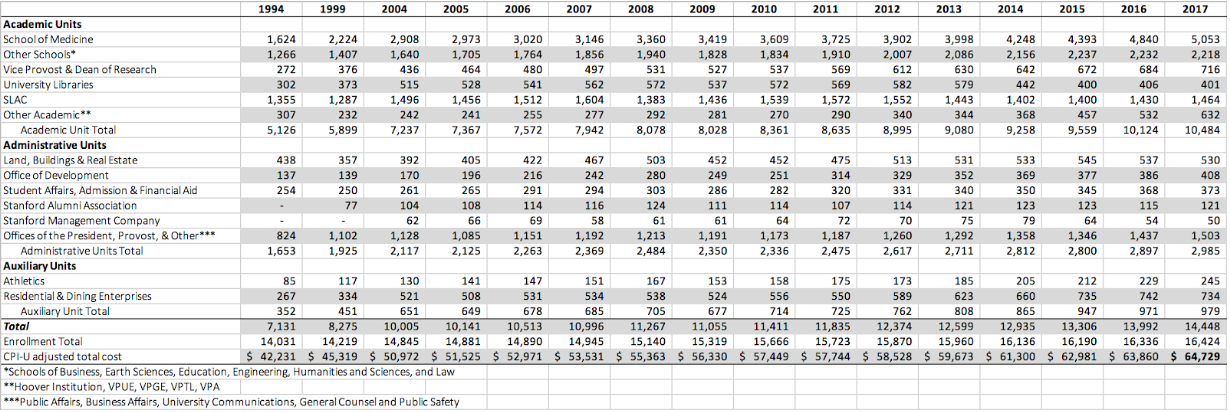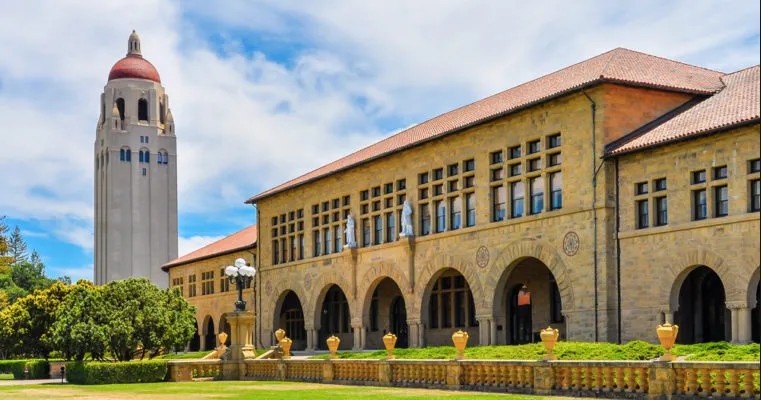Table of Contents
Stanford’s foremost problem is administrative bloat. The University employs 14,448 non-teaching employees, more than double the 6,769 it had on the payroll in 1984 (non-teaching employees include benefits-eligible employees only and does not include students, or employees working less than 50 percent time or hired for less than 6 months). If you think the number of assistants to the deputy to the associate dean of some esoteric administrative department is trivial, follow this thought experiment.
Imagine a university just like Stanford. This university boasts a prestigious faculty, which includes 10 Nobel Laureates, and has held an average rank of 2.7 over the past 9 years in the U.S. News College Rankings. Its alumni include four of nine seats on the Supreme Court. And, this university is making big investments in new buildings, like a 94,000 square foot space for biological sciences. The school does not mandate a Eurocentric curriculum and even asks students to fulfill a gender studies requirement. Of course, this description is not a fiction; it is one of Stanford in 1994.
The campus experience of yesteryear sounds identical to the experience today, with two key differences — tuition and the number of non-teaching employees. The total cost of 1994 attendance (tuition + room & board + mandatory fees) in 2017 dollars was $42,231. Today, tuition is $22,000 higher. Would students rather spend four years at 2018 Stanford, or four years at 1994 Stanford and receive $92,000 in cash? Here is the total cost of attendance and the number of non-teaching employees over the past three decades:

In 33 years Stanford’s cost has doubled! True, the University also employs 927 more professors than is did in 1984:

However, professor growth has more closely matched growth of the student body. And while more teachers per student may have improved the Stanford education, more non-teaching employees seems to have a much more negligible impact on the value of a Stanford diploma. Compared to 1984, Stanford employs 73 percent more non-teaching employees per student and 24 percent more per professor. The number of non-teaching employees should not even grow one for one with enrollment growth because of returns to scale! Here is the total of undergraduate and graduate enrollment alongside the student to non-teaching employee ratio:

Stanford’s student to employee ratio is falling so low, so fast, it could soon be lower than the guest to staff ratio at the nearby $1,000-a-night Rosewood Hotel. Assuming Stanford pays the average non-teaching employee $60,000 per year, a conservative estimate of total compensation including benefits and taxes, these workers cost $867 million per year, 15 percent of the University’s operating expenses.
The operations of the President, Provost, and other administrative offices like communications and business affairs employ 56 percent more workers per student than in 1984. Some units, such as the Office of Development which is tasked to raise far more money than in years past, could perhaps justify more staff. But in the 1980s non-teaching employees were still using punch cards to tabulate data, an army of secretaries to communicate, and a labyrinth of file cabinets to store information. In the digital age, increasing non-teaching employees to feed students, manage the endowment, operate libraries, and run various academic programs is an absurd inefficiency. If anything, given the advances in technology, productivity per employee should be higher.
To be fair, growth of non-teaching employee payroll has been uneven across various parts of the University. Here is a breakdown of Stanford’s non teaching employees by department:

Even-handed analysis should note 47 percent of growth of non-teaching employees since 1994 has been in the School of Medicine, which aside from educating students has some responsibility to provide care. But even disregarding every non-teaching employee in the School of Medicine, Stanford employs so many of these workers in other departments that if it reassigned those staff members from their current duties to provide every undergraduate with a personal butler, then the University would still have 2,300 employees left to service the needs of its 9,400 graduate students. The school of Medicine aside, compared to 1994, the University employs three times as many residential and dining employees, almost twice as many employees in administrative units, and 100 more workers in the ultimate 21st century tool — libraries. Low-productivity non-teaching employees are eating Stanford.
With strong leadership at the top, starving the administrative beast is possible. Purdue President Mitch Daniels was able to do so and has held his institution’s undergraduate tuition constant since 2012. “This place was not built to be efficient,” Daniels told the Wall Street Journal in 2014. “You're not going to find many places where you just take a cleaver and hack off a big piece of fat. Just like a cow, it's marbled through the whole enterprise.” President Marc Tessier-Lavigne should give Daniels a call and ask to borrow his steak knife. He can start by hacking off pieces of marbled fat in his own office before taking the rest of the non-teaching employee payroll to the butcher shop.
Data sourced from Stanford University Annual Financial Report August 31, 2017 and 2016; Stanford University Budget Plan 2018/2019; Stanford University Budget Plan 2017/2018; Stanford University Budget Plan 2013/2014; Stanford University Budget Plan 2002/2003; Stanford University Budget Plan 1994/1995; and Stanford University Operating Budget Guidelines 1986-87.









